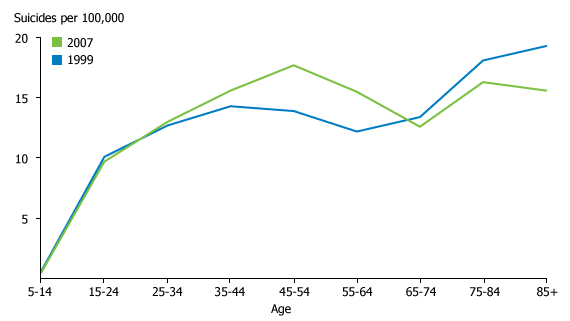Mary Kent
Consultant

November 17, 2010
Consultant
More than 30,000 Americans commit suicide each year; hundreds of thousands more attempt it but fail. As a deliberate act to end one’s own life, suicide appears anathema in a society seemingly obsessed with improving health and prolonging life. Yet suicide was the 11th leading cause of death in the United States in 2007. Suicide brings pain to the families of victims and exacts economic costs for the country.1
The risk of suicide varies greatly by age, sex, and race, and by personal characteristics including education, occupation, family history, and place of residence. For each group, however, depression and substance abuse are key risk factors for suicide.2
In the United States and in many other countries, the suicide rate increases with age (see figure).
U.S. Suicide Rate by Age, 1999 and 2007

Source: WHO, World Report on Violence and Health (Geneva: WHO, 2002).
The highest suicide rates have historically been among the oldest Americans. Many elderly have undiagnosed or untreated depression, which can be intensified by the trauma of losing a spouse or the stress of living with a chronic illness. Elderly adults often lack frequent social interactions that can help protect them against the loneliness that can exacerbate depression. Compared with suicide attempts among younger people, suicides among older adults tend to be carefully planned and more likely to be successful. Many elderly also have underlying health conditions, which reduces their chances of surviving a suicide attempt, compared with younger adults. Suicide rates have actually declined for older adults since 1999, but they remain higher than those in most other age groups.
Until recently, suicide rates leveled off or declined when people were in their 40s and 50s. One common explanation is that middle-aged adults are less likely to consider suicide because they are focused on their careers and raising children, giving them more to live for and a greater sense of responsibility. But that same reasoning may not apply to the baby-boom generation.3 Baby boomers—born between 1946 and 1964—had higher suicide rates than other generations when they were adolescents and young adults, and have higher rates now, as shown for 45-to-64-year-olds in Figure 1. It is not clear why this group has had higher rates, and only time will reveal whether baby boomers will also be more vulnerable to commit suicide in their older ages.
Adolescents and young adults have lower mortality than older groups, but suicide is among the top five causes of death for this age group, usually flanked by homicide and unintentional injury.4 Young adults are vulnerable to suicide in part because they tend to experiment with alcohol and drugs, which are often involved in suicides. They tend to be more impulsive and prone to risky behavior than older adults, and they often are dealing with the stress of major life changes as they assume adult roles.5
Regardless of age, men—white and American Indian men in particular—have the highest suicide rates. The suicide rate for non-Hispanic white men from 2005 to 2007 was 22 deaths per 100,000, more than four times the rate for women of any racial or ethnic group, and more than twice the rate for black, Asian, or Hispanic men. The rate for American Indian men was only slightly lower, at 19 deaths per 100,000.6
Within all these groups, education has a protective effect. More-educated people are less likely to turn to suicide, with some exceptions. Some occupations that require advanced education—such as dentists and physicians—are associated with higher suicide rates, presumably because they often are highly stressful, and perhaps because they have easy access to lethal drugs.7
Likewise, maintaining social relationships protects people from attempting suicide. Married people are much less likely to turn to suicide, but the risk increases after divorce or widowhood. Regular interaction with family members is especially important, but social interactions with nonfamily members—including neighbors, work colleagues, or club members—also lowers suicide risk.
Some population groups have a combination of risk factors that make them especially vulnerable: Military personnel, for example, are predominately young, male, and white. Many are dealing with difficult life situations or trauma and long separations from loved ones.8 And they have access to the most common means for suicide: drugs and firearms. About one-half of U.S. suicides involve firearms, followed by suffocation, especially hanging, at 24 percent and poisoning at 18 percent (including drug overdoses).
Researchers know a lot about what drives people to attempt suicide and how they can be deterred. Prevention efforts include special counseling services; telephone hot lines; screening tests for suicide risk; and reducing access to common means of self injury such as loaded firearms, illegal substances, bridges, and rooftops. The U.S. Army is mounting a large-scale effort to reduce the epidemic of suicides among service personnel.9
